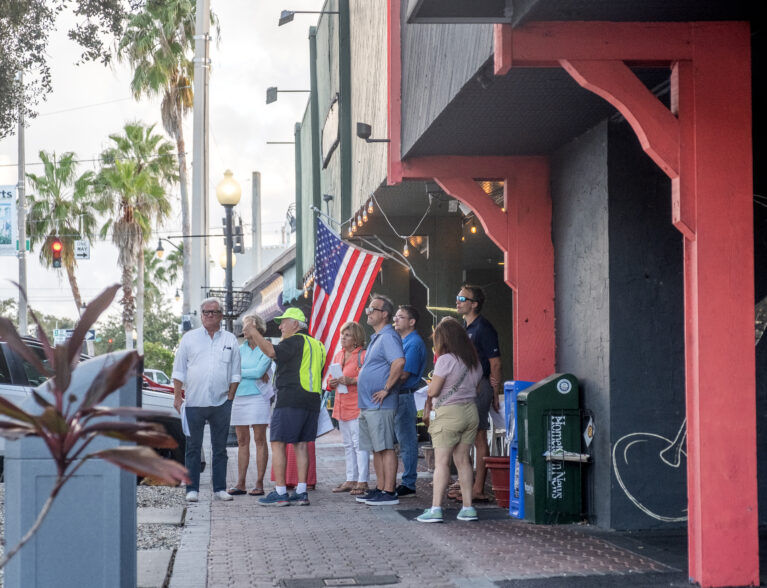
It was only three months ago that a significant majority of Vero Beach voters told the City Council they were satisfied with the organic way the downtown area has been evolving the past 20-plus years.
More specifically: The voters overwhelmingly rejected a pair of Election Day referendums that, if approved, would have more than doubled the residential density limit in the city’s 50-acre downtown core to allow the construction of up to 1,800 studio, one-bedroom and two-bedroom apartments.
So why is the council continuing to invest staff time and city resources to address a problem nearly two-thirds of voters say doesn’t exist?
Why did council members feel compelled to convene a two-hour special-call meeting on Jan. 28 to engage in further discussion of the city’s downtown options in the wake of the referendums’ defeat?
Why did they insist that City Manager Monte Falls and Planning Director Jason Jeffries present at this week’s council meeting an amended path forward for the enhancement of the downtown district?
The answer is as obvious now as it was two years ago, when the council foolishly wasted taxpayer dollars to conduct yet-another downtown traffic study before finally driving a stake through the heart of a wrongheaded, oft-rebuffed campaign to reduce lanes along the Twin Pairs:
There’s a small-but-passionate group of downtown advocates – a vocal minority that includes Vice Mayor Linda Moore and Councilman John Carroll – who believe they are right and the city’s voters are wrong.
They are certain they know what’s best for Vero Beach, especially when it comes to the future of the city’s downtown, and they’re not going to back off.
They see this moment, with two ardent allies and at least one other sympathizer on the council, as their best opportunity to push their agenda. They’re determined to use their political influence to navigate around the failed referendums and get what they want, anyway.
“What do you do when your dreams don’t come true?” Carroll said during the special-call meeting, at which he and Moore gave power-point presentations that offered alternative strategies and tactics the city could employ to make the downtown area more attractive to businesses and the community.
“How do you not let the weight of the results strip the council of its enthusiasm for downtown’s revitalization?” he added. “Obviously, we haven’t lost our enthusiasm, because we’re all here, and we’ve all been thinking about this meeting for a long time …
“How do we, as a council, recover and adjust the downtown revitalization trajectory?”
To be sure, Carroll wasn’t speaking for the entire council, but he made it clear he wasn’t willing to accept the status quo.
Nor was Moore.
She talked about utilizing the existing designation of an Economic Development Zone (EDZ) in the downtown area, as well as the creation of a Business Improvement District (BID), to generate the funds needed to cover the costs of projects to beautify, decorate, illuminate and refurbish the neighborhood.
And as Moore shared her ideas with unbridled enthusiasm – she is rarely as animated as she is when downtown is the topic of discussion – she challenged the city to embrace the possibilities.
“Doing nothing is not an option,” she said.
That’s debatable, given the noticeable lack of overall community support we’ve seen for downtown-improvement initiatives:
- In 2023, the city sponsored a series of public workshops to present the most recent Twin Pairs lane-reduction proposal, and council members quickly learned that most of the community was against it.
- Of the more than 8,000 city residents who voted on the November referendum, which proposed doubling the residential density in the downtown district, only 2,800 supported it.
- Fewer than 40 people, mostly the usual suspects, occupied the chamber for the council’s Jan. 28 special-call meeting to discuss the city’s post-referendum downtown options.
That meeting was scheduled for 6 p.m. in hopes of attracting younger adults who work daytime hours. Few young people cared enough to show up.
Their absence was as telling as it was conspicuous, given that Andres Duany – the urban-planning guru the city hired to create what was a spectacular vision for the revitalization of Vero’s downtown – told council members last year that his concept could succeed only if young adults lived in the downtown.
Or, perhaps, the community’s young adults saw no reason to bother, knowing that voters had already refused to endorse the proposed density increase and transfer of development rights the city sought to build the more-affordable housing necessary to entice that demographic move to downtown.
Those obstacles, however, don’t seem to have discouraged the staunchest downtown advocates, who demand the city continue to support their cause, despite Duany’s warning that his grand plan requires young people to populate the district.
And just so you know: The city isn’t “doing nothing.”
The city already has an established downtown Economic Development Zone – funded by additional revenues generated by increases in property values in the district – and is also in the process of adopting short-term, mid-term and long-term plans to enhance the area.
Among the planned improvements to the streetscape are upgraded lighting, better signage, the addition of decorative flower pots and benches, and a substantial renovation of Pocahontas Park.
City staffers are also exploring limited amendments to the Comprehensive Plan’s land development regulations to permit downtown density increases within current charter restrictions.
Downtown parking will also be addressed.
That should suffice, at least when it comes to the city’s efforts to make downtown more desirable.
Anything more must be the responsibility of the district’s property owners, merchants and restaurateurs, who can take it upon themselves to beautify and maintain the neighborhood’s appearance.
Let Main Street Vero Beach take the lead.
Mayor John Cotugno called the council’s recent willingness to continue to engage with downtown advocates the “normal follow-up to a defeated referendum.”
“We really haven’t forgotten downtown,” the mayor said.
And the council should not forget downtown, which is a place where people regularly gather and is often buzzing with activity. It’s a nice venue that continues to evolve in a way the community seems to like. It’s a vital part of the city.
As the referendums told us, however, there’s no need for the council to make downtown a top priority. Other than sprucing up Pocahontas Park, there’s no pressing concern.
Downtown Vero might not be what Duany believes it could be – or even what its advocates want it to be – but it’s fine the way it is.
Just ask the voters.



